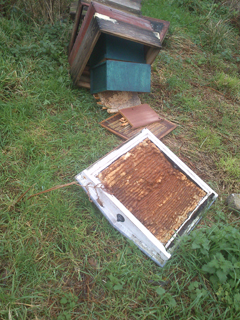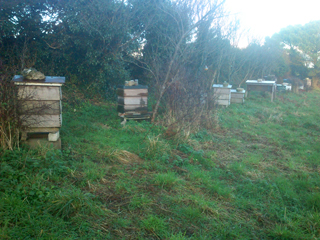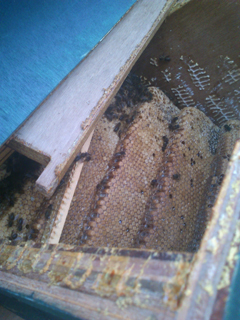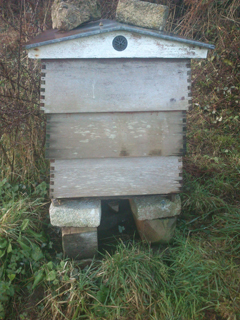 What an end to a very busy season! I had been spending most of my time since the end of the really warm weather during November melting down combs of ivy honey ready for straining and bottling. But then we had some high winds one Thursday night in early December, so the following morning I did my usual walk-about to check that all my hives were still upright – and, horror of horrors, they weren’t!
What an end to a very busy season! I had been spending most of my time since the end of the really warm weather during November melting down combs of ivy honey ready for straining and bottling. But then we had some high winds one Thursday night in early December, so the following morning I did my usual walk-about to check that all my hives were still upright – and, horror of horrors, they weren’t!
Luckily, it was only one hive that had been blown over – the Warré hive, which has the smallest footprint of all hives, being about 1′ square. This design means that the hive tends to end the season being a lot taller than traditional hives but, having this smaller footprint, makes it more liable to toppling by high winds.
So there it was, my favourite (how can one have a favourite?!) hive, on its side, smashed to pieces. As it turned out, things were not as bad as I had initially thought, as the boxes themselves were alright but the combs, since they are drawn from top bars alone and are not, like the traditional wooden framed combs, surrounded by a supporting wooden frame, were all broken free from their top bars.
 The occasional disoriented bee was still to be seen flying disconsolately around, wondering what on earth had happened and what it should do next. As a result, I thought I had lost the lot! The combs, meanwhile, all full of honey which, at this time of the year, had by now crystallised so at least it was not spilling all over the place and attracting the attention of opportunistic bees from other colonies, were just lying in an untidy , forlorn pile in amongst the woodwork. Moreover, these combs were unusable as far as the bees were concerned, as they were each too heavy to be tied back in to the top bar.
The occasional disoriented bee was still to be seen flying disconsolately around, wondering what on earth had happened and what it should do next. As a result, I thought I had lost the lot! The combs, meanwhile, all full of honey which, at this time of the year, had by now crystallised so at least it was not spilling all over the place and attracting the attention of opportunistic bees from other colonies, were just lying in an untidy , forlorn pile in amongst the woodwork. Moreover, these combs were unusable as far as the bees were concerned, as they were each too heavy to be tied back in to the top bar.
As I picked through the mess and started to separate the boxes and their related top bars, I was working from the roof downwards in effect, as the upper parts of the hive had been thrown free of the lower boxes in the fall and so were easiest to retrieve initially. As I rebuilt each part of the hive, placing the (now) empty top bars back into their respective boxes, I could see a cluster of bees hanging on for dear life to the combs in one corner of what had been the bottom box.
 I very carefully lifted this box away from its combs and saw that the latter were still attached to their top bars, since I guess they had not fallen as far as the upper boxes and were therefore not subjected to the shock experienced by the boxes falling from a greater height – the box had effectively just rolled over onto its side. This was why the bees were clustered there, in the gaps between adjacent combs.
I very carefully lifted this box away from its combs and saw that the latter were still attached to their top bars, since I guess they had not fallen as far as the upper boxes and were therefore not subjected to the shock experienced by the boxes falling from a greater height – the box had effectively just rolled over onto its side. This was why the bees were clustered there, in the gaps between adjacent combs.
I had by now replaced the stand in its original location, together with the floor, so placed the bottom box back on the floor. I then lifted each comb, very carefully supporting the comb and its top bar so that they would not break away from each other, and placed it in its original position in its box, together with the adhering bees. During all this deconstruction and reconstruction, the bees were as calm as anything, as if they knew I was saving their lives.
There was not a single bee that tried to sting me and though I was, of course, wearing protective clothing, I did not use any smoke to induce their calm. Once all the combs were back in place, I replaced the second box (which had some whole combs but also bare top bars), the crown board (ceiling) and roof and left the bees to it. There were by now many bees flying around the site of the fallen hive, because that is where they thought their “new” home was, but it wasn’t long before the ones in the re-instated hive were fanning their homing-scent and the slowcoaches eventually rejoined their sisters in the hive.
 So, the hive was rebuilt and the bees were inside – but did they have a queen or had she been crushed in the tumble? Throughout the rebuilding exercise, I only found, literally, about half a dozen crushed bees, none of which was the queen. I can only assume, therefore, that the bees that survived did so because they were in the lower box (that had not been thrown so far) and the bees that had been crushed just happened to be in the upper part of the hive at the time it went over. As for the queen, only time would tell.
So, the hive was rebuilt and the bees were inside – but did they have a queen or had she been crushed in the tumble? Throughout the rebuilding exercise, I only found, literally, about half a dozen crushed bees, none of which was the queen. I can only assume, therefore, that the bees that survived did so because they were in the lower box (that had not been thrown so far) and the bees that had been crushed just happened to be in the upper part of the hive at the time it went over. As for the queen, only time would tell.
So the following day I went to check the hive and, lo! and behold!, of all the hives in the apiary, this was the only one with bees flying – in their tens! Not only that, they were bringing in bucket-loads of pollen (making good their loss from the removed, broken combs, no doubt). This augers well for the survival of the colony, so I am hopeful they will come through the winter unscathed. Just to make doubly sure, I have given them a feed of fondant which they are getting through like a young child gets through a packet of sweets, so this is another good sign that all is well.
If this colony makes it through the winter, it will be a good one to breed from – it’s obviously a survivor, is very calm and produces a good harvest of honey. I can’t wait for the new season to start!
Colin Rees – 01872 501313 – colinbeeman@aol.com

